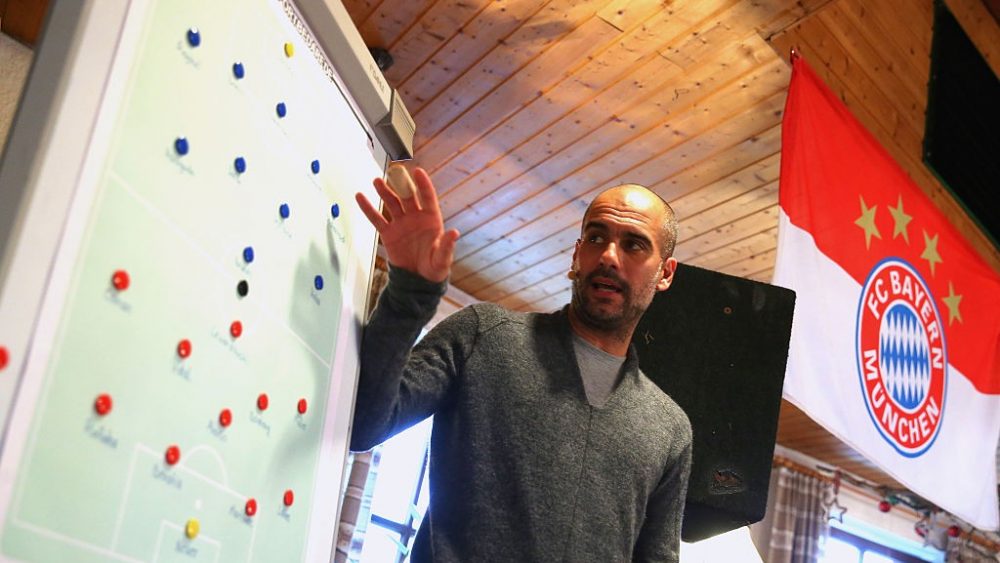Tactics-Blog #001 – The role of formations
433. This is not the number of comments left by readers on an article of ours about a Bayern defeat against Dortmund, it is a combination of numbers that has been intensively discussed following the Supercup match.
Niko Kovač and his coaching staff changed their team’s basic formation from its familiar 4-2-3-1 to a 4-3-3 in pre-season preparation. They did this before last season too, with mixed success, and now this formation gets a second chance.
In his first year, Kovač had to revert from a 4-3-3 to a 4-2-3-1 formation because pressure from within the club was mounting and he wanted to give his team more stability in defensive midfield. Often a change in formation is described as a change in tactics, but there are a lot of wrong preconceived notions about this.
„This has never worked“
Just now, after the 0-2 defeat in the Supercup, the 4-3-3 has come under scrutiny again. Worthy of particular note is the suggestion that the positions it provided for on the pitch did not match the squad’s strengths.
While Müller could not play in his accustomed role behind the centre forward, Thiago was left alone as the single pivot in front of defence. Carlo Ancelotti had already proved before that a 4-3-3 did not work. „This has never worked“ has been the general tenor of the debate.
It is prejudices like this that highlight the overstated importance given to the positions designated by a formation‘s numbers. All these positions can do is to provide orientation. Beyond that they are of little value. Former Bayern manager Pep Guardiola disrespectfully called them „phone numbers“ for a reason.
Number eight? Number ten? What do I care?
Not every 4-3-3 is alike. Last season, Niko Kovač played a different variety of 4-3-3 than Carlo Ancelotti had done the season before. And this year’s Niko Kovač plays, yes, a different variety again.
Football is about defending spaces and using spaces. There are tactical roles for groups of players and individual players, as well as certain patterns of play for specific match situations. However, it is true that each different formation comes with its own advantages and disadvantages.
But why should a 4-3-3 not allow a player to occupy certain spaces which nominally his position does not cover? Thomas Müller will probably find the same spaces and make the same runs as a number eight in a 4-3-3, as he would as a number ten in a 4-2-3-1 formation – unless his coach explicitly does not want him to. Otherwise Müller will likely say: “Number eight? Number ten? What do I care?”
A change only on paper is not enough
So if at times a team’s two number eights are positioned too high up the pitch as it happened to Bayern in their match against Dortmund, the answer should not be a knee jerk reaction to blame the formation. When, frankly, is any player ever placed in his exact position other than before kick off? The answer should be to find ways to ensure that players occupy the right spaces at the right times.
Which tactical options are there to support the number six? Which situations in a game demand which players to move where? How can other players compensate defensively for an offensive Müller without becoming too passive?
These are the questions that should frame a debate about tactical approaches. A shift from a 4-3-3 to a 4-2-3-1 alone does not change anything as long as it occurs only on paper. It is about finding the best position for every player. And what suits one match may be unsuitable for the next one, sometimes even the next situation of the same one, due to the dynamic nature of a football match where players, conditions, movements, atmosphere etc. are always in flux.
Tactics is more than just phone numbers
Yes, tactics can be complicated at times. But it is an oversimplification to say that a certain combination of numbers will invariably yield a certain outcome. Bayern’s preparations showed that a 4-3-3 has a lot of positives despite its ostensible lack of certain positions.
So it is now up to Kovač and his staff to learn the right lessons from the defeat against Dortmund. Then perhaps we really will see 433 comments after the next match against Dortmund – all praising how outstanding Müller was in occupying the number ten space from a number eight position.
Or how aptly the second number eight compensated for Müller’s offensive runs by supporting the single holding midfielder. Because only rarely has a debate about phone numbers ever been productive. Or, to adopt the currently popular rhetoric: this has never worked!
Key takeaways
- Formations serve as orientation. Beyond that they are of little value. A 4-3-3 can be implemented in various ways.
- It is more important to think in spaces and roles.
- Which are the “right” spaces and roles will change from match to match, sometimes even within a match.









